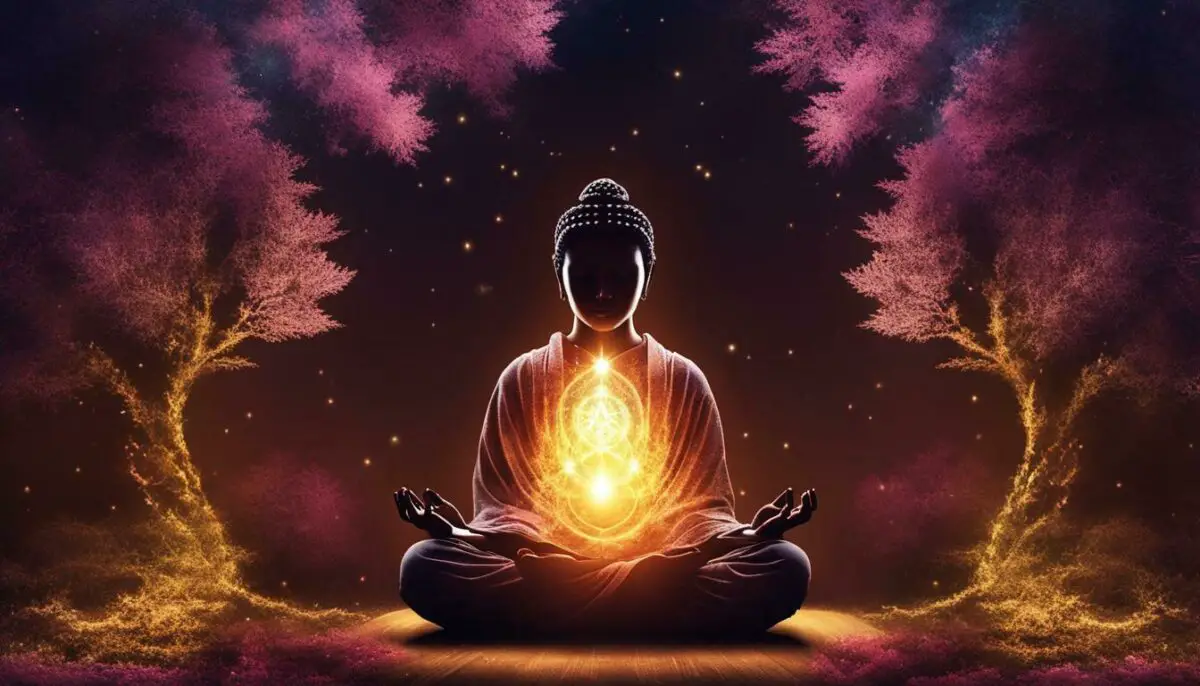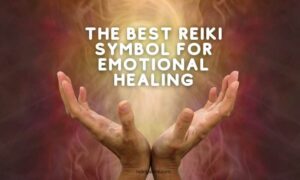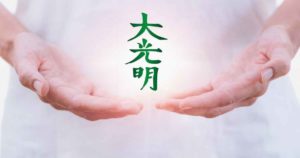Welcome to my comprehensive guide on Reiki Symbol Interpretation. In this article, we will explore the meaning and significance of various Reiki symbols, giving you the tools to unlock wellness and tap into the healing potential of Reiki energy.
Key Takeaways:
- Reiki symbols are sacred emblems used by practitioners to activate and direct specific energies.
- Common Reiki symbols include Cho Ku Rei, Sei Hei Ki, Hon Sha Ze Sho Nen, Dai Ko Myo, and Raku.
- These symbols can be used together or separately to achieve different healing goals.
- While not necessary for Reiki healing, symbols serve as teaching tools to help practitioners change the way Reiki energy functions.
- The intention and energy of the practitioner are the most important aspects of Reiki healing.

What Are Reiki Symbols?
Reiki symbols are sacred emblems that hold specific meanings and energies, playing a vital role in the practice of Reiki healing. Let’s delve deeper into the world of these symbols and uncover their hidden power. Each symbol represents a unique aspect of Reiki energy and serves as a tool for Reiki practitioners to access and direct specific healing energies.
Reiki symbols are not necessary for Reiki healing, but they enhance the practitioner’s ability to channel and focus energy. These symbols are powerful aids that help practitioners tap into the universal life force energy to facilitate healing on physical, emotional, and spiritual levels. By incorporating these symbols into their practice, Reiki practitioners can amplify the effectiveness of their healing sessions.
“Reiki symbols are the keys that unlock the limitless healing potential within us.”
Some of the most commonly used Reiki symbols include Cho Ku Rei, Sei Hei Ki, Hon Sha Ze Sho Nen, Dai Ko Myo, and Raku. Each symbol holds its own specific meaning and purpose. Cho Ku Rei, for example, is known as the power symbol and is used to increase the strength of Reiki energy and provide protection. Sei Hei Ki, also known as the emotional and mental healing symbol, brings balance and harmony to emotional and mental energies. Hon Sha Ze Sho Nen, the distance healing symbol, enables Reiki practitioners to send healing energy across time and space. Dai Ko Myo, the master symbol, activates the highest level of Reiki energy, while Raku symbolizes grounding and stability.
| Symbol | Meaning | Purpose |
|---|---|---|
| Cho Ku Rei | Power Symbol | Increases Reiki energy and provides protection |
| Sei Hei Ki | Emotional and Mental Healing Symbol | Brings balance and harmony to emotional and mental energies |
| Hon Sha Ze Sho Nen | Distance Healing Symbol | Enables distance healing across time and space |
| Dai Ko Myo | Master Symbol | Activates the highest level of Reiki energy |
| Raku | Grounding Symbol | Brings grounding and stability |
Understanding the meanings and functions of these symbols is essential for Reiki practitioners to harness their power and incorporate them effectively into their healing practice. By mastering the interpretations of these symbols, practitioners can unlock profound healing experiences and promote overall well-being.
Understanding Key Reiki Symbols
Let’s explore three essential Reiki symbols – Cho Ku Rei, Sei Hei Ki, and Hon Sha Ze Sho Nen – and their significance in activating and directing specific energies for healing and well-being.
The Cho Ku Rei symbol, also known as the Power Symbol, is widely used in Reiki to increase the power of healing energy. It acts as a spiritual switch, amplifying the flow of Reiki and providing protection during healing sessions. The symbol is often drawn or visualized at the beginning of a session to activate the healing energy and enhance its effectiveness.
The Sei Hei Ki symbol, known as the Mental/Emotional Symbol, holds the power to heal emotional and mental problems. It works by clearing negative emotions and promoting emotional balance. Reiki practitioners often use this symbol to address trauma, anxiety, and depression. By incorporating the Sei Hei Ki symbol into their healing practice, practitioners can help individuals find inner peace and achieve emotional well-being.
The Hon Sha Ze Sho Nen symbol, called the Distance Symbol, enables Reiki practitioners to send healing energy across time and space. It acts as a bridge, allowing Reiki energy to connect with individuals who are not physically present. By using this symbol, practitioners can offer healing to someone who may be located far away or even in a different time. This symbol is particularly useful in distance healing sessions, where physical presence is not possible.
| Symbol | Meaning | Function |
|---|---|---|
| Cho Ku Rei | Power Symbol | Increases Reiki power and provides protection |
| Sei Hei Ki | Mental/Emotional Symbol | Heals emotional and mental problems, promotes balance |
| Hon Sha Ze Sho Nen | Distance Symbol | Enables distance healing across time and space |
These three symbols, Cho Ku Rei, Sei Hei Ki, and Hon Sha Ze Sho Nen, play a crucial role in Reiki healing. They activate and direct specific energies, allowing practitioners to harness the power of Reiki for healing and well-being. By understanding and incorporating these symbols into their practice, Reiki practitioners can enhance the effectiveness of their healing sessions and promote holistic healing.
Additional Reiki symbols
There are two additional symbols worth exploring – Dai Ko Myo and Raku.
The Dai Ko Myo symbol, also known as the Master Symbol, activates the highest level of Reiki energy. It is often used in attunements to connect individuals with the spiritual source of Reiki. This symbol brings deep healing and spiritual transformation, allowing practitioners to access higher realms of consciousness and wisdom.
Raku, the symbol of grounding, is used to settle and stabilize energy. It helps practitioners stay rooted and connected to the Earth’s energy, promoting balance and harmony. This symbol is particularly useful for individuals who feel scattered or ungrounded and can assist in calming an overactive mind.
By exploring and understanding the meanings and functions of these Reiki symbols, practitioners can expand their healing repertoire and unlock new possibilities for wellness and spiritual growth. Whether used individually or in combination, these symbols serve as powerful tools that facilitate healing and transformation.
Unlocking the Power of Reiki Symbols
By unlocking the power of Reiki symbols and mastering their meanings, you can enhance the healing capabilities of Reiki energy and elevate your practice to new heights of wellness and harmony. Reiki symbols are sacred emblems that hold specific energies and serve as powerful tools for directing and amplifying the flow of healing energy.
One of the most commonly used symbols is Cho Ku Rei, which increases the power of Reiki and provides protection during healing sessions. It acts as a spiritual light switch, instantly activating the flow of Reiki energy. Another important symbol, Sei Hei Ki, is known for its ability to heal emotional and mental problems. It helps create balance by releasing negative emotions and promoting inner peace and clarity.
The Hon Sha Ze Sho Nen symbol is particularly significant for distance healing, as it allows practitioners to send Reiki energy across time and space. By focusing on this symbol, one can connect with the intended recipient and channel healing energy to them, regardless of their physical location. Dai Ko Myo symbol, often referred to as the master symbol, activates the highest level of Reiki energy. It is associated with enlightenment and spiritual transformation.
One symbol that helps ground and settle the body is Raku. It serves as an anchor, promoting stability and balance during Reiki healing sessions. By incorporating Raku into your practice, you can create a solid foundation for the energy to flow harmoniously, ensuring a more grounded and centered experience.
| Reiki Symbol | Meaning |
|---|---|
| Cho Ku Rei | Increase power and protection |
| Sei Hei Ki | Heal emotional and mental problems |
| Hon Sha Ze Sho Nen | Enable distance healing |
| Dai Ko Myo | Activate highest level of Reiki energy |
| Raku | Ground and settle the body |
These symbols can be used individually or in combination to achieve different healing goals. When incorporated with focused intention and energy, Reiki symbols can unlock profound healing experiences, promoting physical, emotional, and spiritual well-being.
“Reiki symbols are like keys that unlock the door to healing and harmony.”
It is important to note that Reiki symbols are not necessary for Reiki healing, as the practitioner’s intention and energy are the most essential aspects. However, these symbols serve as valuable teaching tools that assist in changing the way Reiki energy functions. By understanding and mastering the meanings of these symbols, you can further enhance your practice and tap into the full potential of Reiki energy.
In summary, Reiki symbols are sacred emblems that hold specific energies and meanings. By unlocking their power and mastering their meanings, you can enhance your Reiki practice and elevate your healing capabilities. Incorporating symbols like Cho Ku Rei, Sei Hei Ki, Hon Sha Ze Sho Nen, Dai Ko Myo, and Raku can help you achieve different healing goals and expand your repertoire of healing techniques. Remember, the key to unlocking the power lies within your intention and energy as a practitioner, and Reiki symbols serve as powerful aids on your healing journey.
Using Reiki Symbols Together
Combining multiple Reiki symbols can amplify their healing effects and unlock new levels of energy flow. To help you interpret the hidden messages of these symbols and use them effectively together, this section serves as your comprehensive guide.
When using Reiki symbols in combination, it’s essential to consider their individual meanings and purposes. Each symbol carries a unique energy and intention, which, when combined, create a powerful synergy. For example, the Cho Ku Rei symbol can enhance the overall power of Reiki, while the Sei Hei Ki symbol is specifically used for healing emotional and mental problems.
To fully harness the potential of combining Reiki symbols, it’s important to set clear intentions and visualize the desired outcome. By focusing your energy on the specific healing goal and invoking the appropriate symbols, you can enhance the flow of Reiki energy and facilitate deeper healing experiences.
| Symbol | Meaning | Intention |
|---|---|---|
| Cho Ku Rei | Power and protection | Amplify Reiki energy and provide energetic shield |
| Sei Hei Ki | Emotional and mental healing | Address emotional blockages and promote balance |
| Hon Sha Ze Sho Nen | Distance healing | Connect with recipients remotely and send healing energy |
Experimenting with different combinations of Reiki symbols can lead to a deeper understanding of their interactions and effects. However, it’s important to trust your intuition and listen to the subtle guidance from within. As you practice and gain experience, you’ll develop your own unique style and preferences when it comes to using Reiki symbols together for healing and transformation.
The Role of Reiki Symbols in Teaching
Reiki symbols not only serve as tools for healing but also play a crucial role in teaching and learning Reiki. Let’s delve into how these symbols aid in understanding and transforming the way Reiki energy is channeled.
Reiki symbols, such as Cho Ku Rei, Sei Hei Ki, Hon Sha Ze Sho Nen, Dai Ko Myo, and Raku, are sacred emblems that hold specific meanings and energies. When introduced to students, these symbols provide visual representations of the concepts and energies they represent, facilitating a deeper understanding of Reiki principles and practices.
By incorporating Reiki symbols into teaching sessions, instructors can guide students in harnessing the power of these symbols to cultivate a greater connection with Reiki energy. The symbols act as visual aids, helping students visualize and focus their intention on specific healing aspects. This deeper understanding of how Reiki symbols work allows students to effectively utilize them in their own healing practices, amplifying the healing potential of Reiki energy.
The Role of Reiki Symbols in Practice
During Reiki training, students learn to draw and activate the symbols. This process not only helps them memorize the symbols but also deepens their connection to the energies associated with each symbol. Through the repetition and practice of drawing the symbols, students develop muscle memory and energetic resonance with each symbol. This practice becomes an integral part of their Reiki journey, solidifying their understanding and usage of the symbols.
Additionally, Reiki symbols act as a bridge between the conscious and subconscious mind. They serve as visual cues that trigger the flow of Reiki energy, allowing practitioners to easily access and direct the healing energy. This integration of symbols in practice promotes intuitive healing and opens doors to heightened levels of healing possibilities.
In conclusion, the use of Reiki symbols in teaching Reiki not only aids in understanding the concepts and energies behind Reiki but also enhances the practitioner’s ability to tap into the transformative power of Reiki energy. These symbols provide a tangible connection and guidance, enabling practitioners to explore the depths of their healing potential.
| Reiki Symbols | Meanings |
|---|---|
| Cho Ku Rei | Increases power, provides protection |
| Sei Hei Ki | Heals emotional and mental problems |
| Hon Sha Ze Sho Nen | Allows for distance healing |
| Dai Ko Myo | Activates the highest level of Reiki energy |
| Raku | Grounds and settles the body |
The Importance of Intention and Energy
While Reiki symbols are powerful tools, it is crucial to understand that the true essence of healing lies in the intention and energy of the practitioner. In this section, we explore why your intention and energy are the driving forces behind effective Reiki healing, supported by the correct interpretation of symbols.
Reiki symbols act as gateways, allowing practitioners to tap into specific energies and direct them for healing purposes. However, without the practitioner’s focused intention and positive energy, the symbols alone are not enough to bring about profound healing experiences. It is the intent behind the symbols that sets the healing process in motion.
When you approach Reiki healing with clear and pure intentions, you create a powerful energetic field that amplifies the effects of the symbols. Your intentions act as a magnet, drawing in the healing energies and directing them to the areas that require healing. Through your focused intention, you become a channel for the divine healing energies to flow.
Furthermore, the energy you bring to your Reiki practice plays a vital role in the healing process. Your energy field, which is influenced by your thoughts, emotions, and overall well-being, interacts with the universal life force energy to facilitate healing. When you cultivate a high vibrational energy, characterized by love, compassion, and positivity, you enhance the effectiveness of the symbols and deepen the healing experience.
In conclusion, while understanding and utilizing Reiki symbols is important, the true power of healing lies within you – in your intention and energy. By aligning your intentions with the symbols and infusing your healing practice with positive energy, you can unlock the full potential of Reiki symbols and experience profound physical, emotional, and spiritual healing.
Using Reiki Symbols for Distance Healing
Distance healing is an integral part of Reiki, allowing healing energy to transcend time and space. In this section, we explore how Reiki symbols, specifically Hon Sha Ze Sho Nen, can be interpreted to facilitate effective distance healing.
When engaging in distance healing, the Hon Sha Ze Sho Nen symbol plays a crucial role. It enables Reiki practitioners to connect with the recipient’s energy regardless of physical proximity. By visualizing the symbol and intending for Reiki energy to flow, practitioners can establish a direct energetic link and transmit healing energy over any distance.
Interpreting the hidden messages of the Hon Sha Ze Sho Nen symbol is essential for effective distance healing. This symbol represents the interconnectedness of all beings and acts as a bridge between the practitioner and the recipient. Its meaning can be decoded as “The Buddha in me reaches out to the Buddha in you.” This interpretation serves as a reminder that we are all divine beings connected by a universal life force.
“The Buddha in me reaches out to the Buddha in you.”
To facilitate distance healing, practitioners can draw or visualize the Hon Sha Ze Sho Nen symbol, along with the other Reiki symbols if desired. They can then use their hands to send Reiki energy, trusting in the power of intention and the universal life force to guide the healing process. By maintaining a focused mindset and allowing the Reiki energy to flow, practitioners can effectively channel healing vibrations to the recipient, regardless of their physical location.
Using Reiki symbols for distance healing expands the possibilities of healing beyond physical limitations. It is a testament to the interconnectedness of all beings and the limitless potential of Reiki energy. By understanding and interpreting the hidden messages within these symbols, practitioners can unlock the profound healing experiences that distance healing offers.
| Key Points |
|---|
| Distance healing allows healing energy to transcend time and space. |
| The Hon Sha Ze Sho Nen symbol facilitates effective distance healing in Reiki. |
| Interpreting the hidden messages of the symbol enhances the connection between practitioner and recipient. |
| Practitioners can visualize and use hand positions to send Reiki energy during distance healing. |
The Significance of Grounding with Raku
Grounding is a vital aspect of maintaining balance and stability in Reiki practice. Let’s explore the significance of grounding with the Raku symbol and understand how it aids in settling the body and energy.
In the Reiki tradition, the Raku symbol plays a key role in grounding and stabilizing the practitioner’s energy. Represented by a horizontal line between two vertical lines, Raku symbolizes the connection between heaven and earth. This symbol acts as an anchor, helping practitioners stay rooted and centered during their healing sessions.
By focusing on the Raku symbol, practitioners can bring their energy down to the earth, allowing a sense of stability and balance to permeate their being. As they channel Reiki energy, the Raku symbol assists in grounding this highly transformative energy, preventing it from causing imbalance or disorientation.
| Raku Symbol |
|---|
| The Raku symbol is used for grounding and stabilizing energy in Reiki practice. |
Furthermore, grounding with the Raku symbol helps practitioners become more present and connected to the physical world. It allows them to be fully embodied in their healing work, enhancing their ability to sense and channel energy effectively. This grounding not only benefits the practitioner but also contributes to the overall well-being and comfort of the client during a Reiki session.
By utilizing the power of the Raku symbol, Reiki practitioners can access a deeper sense of stability and balance. Grounding with Raku serves as a foundation for successful Reiki practice, enabling practitioners to create a safe and nurturing space for healing to unfold. Incorporating this symbol into daily Reiki rituals can enhance the effectiveness and potency of the energy being channeled, promoting profound healing experiences.
Exploring the Healing Potential of Reiki Symbols
Reiki symbols possess immense healing potential, transcending boundaries and unlocking wellness on multiple levels. In this section, we explore the depths of this potential and how you can harness it to transform your life.
One of the most powerful aspects of Reiki symbols is their ability to amplify and direct energy. Each symbol carries a specific meaning and purpose, allowing practitioners to channel healing energy with intention and focus. Whether it’s the Cho Ku Rei symbol that increases the power of Reiki or the Sei Hei Ki symbol that heals emotional and mental problems, these symbols serve as gateways to profound healing experiences.
Furthermore, Reiki symbols can be used in combination, creating a synergy that magnifies their individual effects. For example, the Dai Ko Myo symbol activates the highest level of Reiki energy, while the Raku symbol grounds and settles the body. By using these symbols together, practitioners can access a broader range of healing possibilities and tailor their approach to specific needs.
It’s important to note that while Reiki symbols are powerful tools, they are not essential for practicing Reiki. The true essence of Reiki lies in the intention and energy of the practitioner. The symbols simply serve as guides and reminders, helping to enhance and direct the practitioner’s innate healing abilities. With dedicated practice and understanding, you can unlock the full potential of Reiki symbols and experience profound transformation and healing in your life.
| Symbol | Meaning | Function |
|---|---|---|
| Cho Ku Rei | Increase power of Reiki, provide protection | Amplify healing energy, shield from negativity |
| Sei Hei Ki | Heal emotional and mental problems | Restore balance, release emotional blockages |
| Hon Sha Ze Sho Nen | Allow for distance healing | Connect across time and space, send healing energy |
| Dai Ko Myo | Activate highest level of Reiki energy | Elevate spiritual connection, promote enlightenment |
| Raku | Ground and settle the body | Stabilize energy, foster balance and stability |
Conclusion
As we conclude this guide on Reiki Symbol Interpretation, we hope you have gained a deeper understanding of the meanings and significance behind these sacred emblems. By unlocking the power of Reiki symbols and mastering their interpretation, you can embark on a path of wellness, healing, and harmony in your life.
Reiki symbols are sacred emblems used by Reiki practitioners to activate and direct specific energies. They serve as valuable teaching tools that help practitioners understand and change the way Reiki energy functions. However, it is important to note that while these symbols can enhance the healing potential of Reiki, they are not necessary for Reiki healing itself.
The core aspects of Reiki healing lie in the intention and energy of the practitioner. It is through a genuine and focused intention, combined with the flow of positive energy, that true healing can occur. The symbols simply act as aids to enhance and direct that energy, amplifying their effectiveness.
Some common Reiki symbols include Cho Ku Rei, which increases the power of Reiki and provides protection; Sei Hei Ki, which heals emotional and mental problems; Hon Sha Ze Sho Nen, which allows for distance healing; Dai Ko Myo, which activates the highest level of Reiki energy; and Raku, which grounds and settles the body.
By understanding and utilizing these symbols, either individually or in combination, you can further unlock the limitless healing potential of Reiki. Whether you seek physical, emotional, or spiritual well-being, Reiki symbols can guide you on your journey towards holistic balance and harmony.




